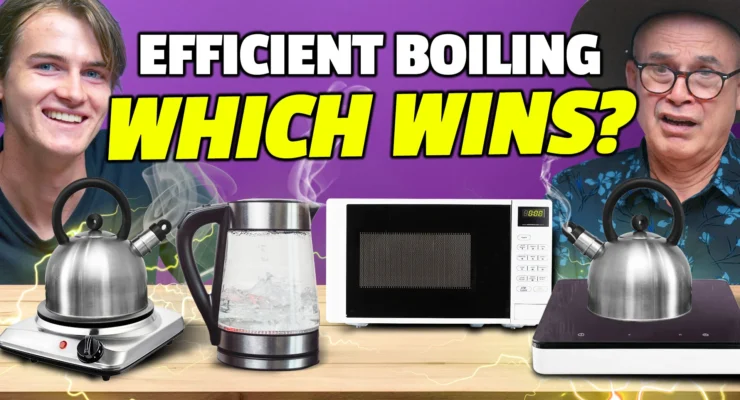
Fast read
In the video, Markus Lambert and his guest Jono, the Journo compare the energy efficiency of different appliances for making a cup of tea. They test the microwave, electric kettle, electric hot plate, and induction stove to measure their time and power consumption.
The microwave is the fastest but consumes a significant amount of energy. The electric hot plate is the slowest and least efficient method.
The induction stove is fast and relatively efficient. However, the most energy-efficient and speedy option is the electric kettle, which boils water quickly while using the least amount of energy.
The video highlights the importance of using energy efficiently to contribute to a greener world and mentions potential electricity savings if more people switch to efficient methods.
A race to heat hot water – which appliance is the most efficient?
Markus Lambert: I do love a good cup of tea and have always wondered how much energy it takes to make one. Today, we’ll explore the energy required for your daily brew using different methods. Jono, what’s the most common way to boil water?
Jono: The electric kettle is the most common electrical appliance used to boil water.
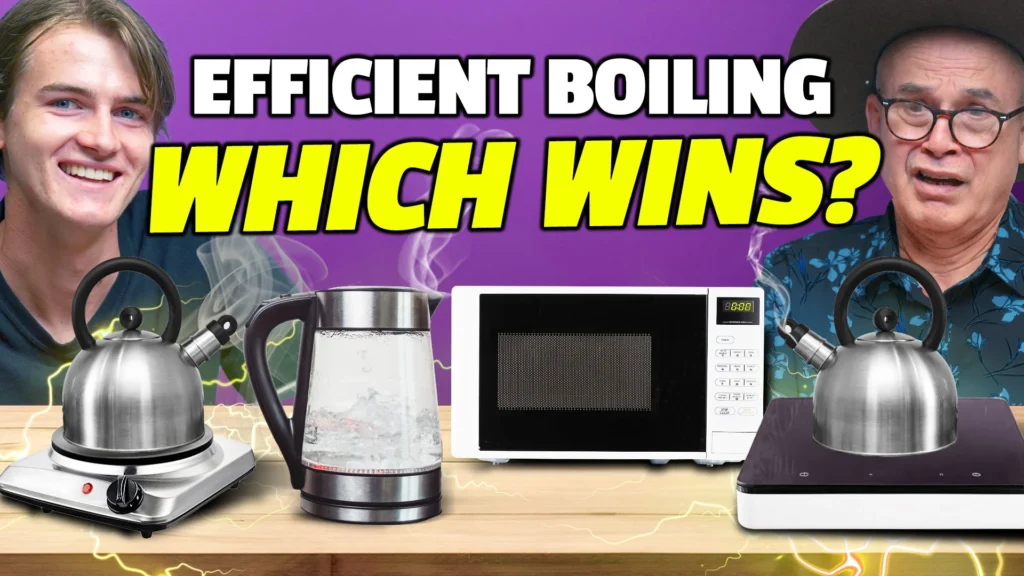
Markus Lambert: Right, everyone has one. We also have the microwave, the lazy way to heat water. And the old-school electric stove represented by a hot plate. Lastly, we have the induction stove, a more futuristic option.
So which appliance will be the fastest and most energy efficient? Jono, who do you think will win?
Jono: I think the microwave will be the fastest. I boil water directly in my cup for my morning coffee. What’s your bet?
Markus Lambert: I’m going with the electric kettle. Explaining: We’ve taken 600 millilitres of water at room temperature. Jono will time how long it takes to boil it, and we’ll measure the wattage using a smart energy meter. Let’s start with the microwave.

Jono: Impressive, but it consumes a lot of power. Let’s move on to the other methods.
The electric hot plate takes forever. It’s one of the least efficient ways to boil water. Now, let’s try the induction stove. It’s quick!
Markus: What about the cost?
Jono: It’s slightly more than the microwave.
Markus: Finally, let’s test the electric kettle.
Jono: It’s drawing a lot of power at the beginning. It’s the fastest!
Markus: The electric kettle is the clear winner.
Jono: It’s also the most efficient and safer.
Markus: If someone uses the electric kettle instead of an inefficient hot plate for a year, they will save around $14 in electricity. If 10 million people in Australia made the switch, it would save $143 million in electricity. That’s a significant impact.
Jono: So using electricity efficiently adds up and contributes to a greener world.
Markus: Absolutely. Enjoy your cup of tea guilt-free.
Markus: I do love a good cuppa, but I’ve always wondered how much energy it takes to make the perfect cup of tea. Today we’d be spilling the beans on the energy required for your daily brew. Obviously, you boil the water in many different ways. So Jono, what’s the most common way to boil water?
Jono: Well, firstly, Markus, the coloured water isn’t really my cup of tea. I need something a little bit stronger each morning. And the most common electrical appliance used to boil water is the electric kettle.
Markus: The thing that’s in everybody’s house.
Jono: Then we have the good old microwave.
Markus: The lazy man’s method to heat the water.
Jono: And don’t forget the old-school electrical stove, which is represented by a hot plate. And then, finally, we have the future, the induction stove.
Markus: What’s this Alien contraption?
Jono: Alright then, let’s see which of these appliances will reign supreme when it comes to speed and energy efficiency.
Markus: Sir Jono, who you’re backing for Jono this?
Jono: Surely it’s the microwave. You can boil it directly from your cup, and that’s how I have my morning coffee every day.
Markus: But when you take it out, there’s a lot of energy in the cup.
Jono: Well, if you think you’re right, who do you think is gonna win?
Markus: The electric kettle.
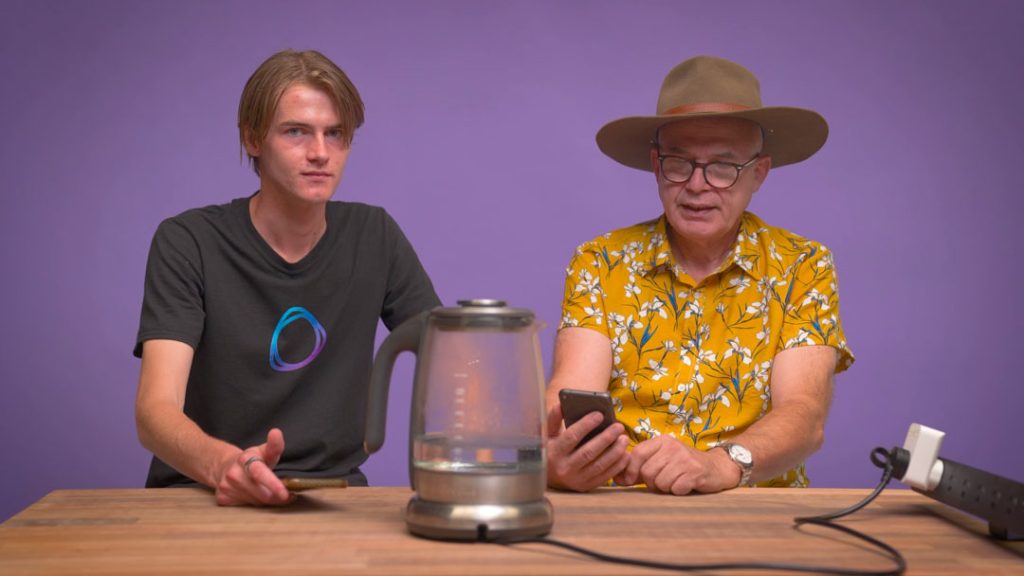
Jono – to the audience: Well, before we flick on all the switches and run up our electric bill, which of these do you think will be the most efficient? Leave a 2 cents in the comments below.
Let the curious energy begin.
Markus: So we’ve taken 600 millilitres of water at room temperature, and Jono will take the time for how long it takes to get it to the boiling point.
Jono: And then we’re gonna use this smart energy meter by TP-link to measure the wattage our appliances use. Through an app. If you’re interested in our review of this particular smart meter, check out our link in the description below.
Markus: Our first test, the microwave.
Jono: Wow, Marcus, you really do live in the past.
Markus: That was impressive. What about the rest? Oh, so what about tea and coffee? We are seeing a power consumption of around 1,160. That’s about the same as about two washing machines. Oh, wow. Now it just depends on how long it takes. A cup of tea day keeps the problems.
Jono: Well, I think you got bigger problems. So this took three minutes and 30 seconds to make our cup of tea with the microwave, and that was about 1,140 watt ish per second. So, Markus, why don’t you tell us the cost?
Markus: That’s about 2 cents per cup.
Jono: Well, it seems like a bargain to me, but let’s give it something to compare. Let’s see how the good old electrical hot plate goes.
Markus: The kettle, it’ll take forever. So here we’re looking at a consistent consumption at the moment of about 1,330 watts. Which is a little bit more than what the microwave did with 1140. Okay. I think that’s it. Wow. That’s taking a long time.
Jono: This was about seven minutes and 15 seconds. That’s an eternity for a cup of tea. Honestly, I think this might be one of the least efficient ways to boil a cup of water.
Markus: Well, hang on. We’ve got other ways to go.
Jono: Why don’t you tell us the cost, Markus?
Markus: Uh, that’s 5.17 cents.
Jono: Damn. That’s more than double the microwave.
Markus: Let’s go for the next method – induction. Far-out. Oh, sweet crocodile, it draws 1,936 watts. Oh, here we go. That was quick.
Jono: And stop – two minutes and 10 seconds. That’s faster than the hot plate and the microwave.
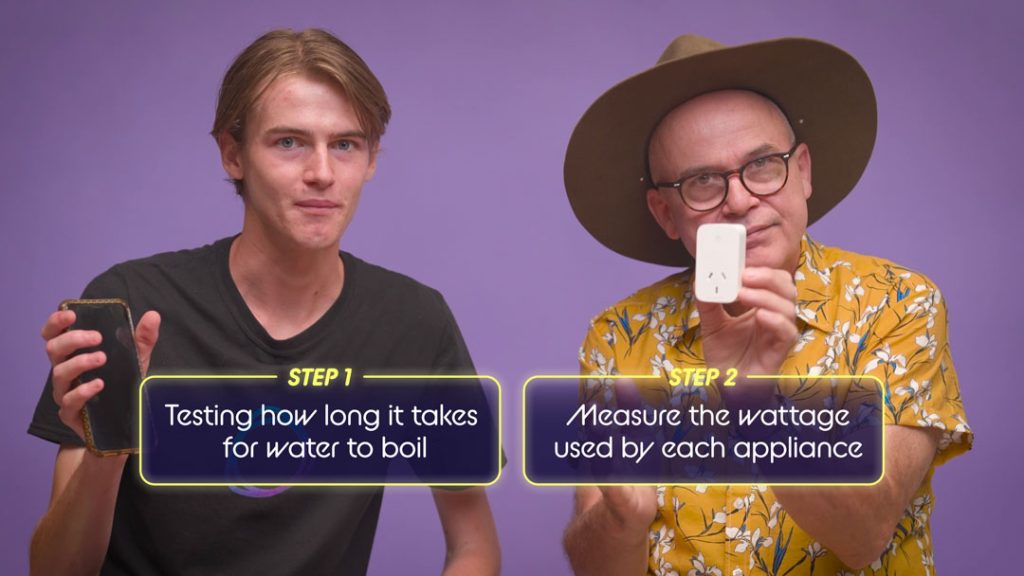
Jono: So, Markus, what’s the cost?
Markus – calculating: Uh, 130 seconds, x the wattage. It’s 2.10 cents.
Jono: Tiny bit more than the microwave. Do you know what that means? My microwave’s still on top. More efficient and safer as well.
Markus: Yeah. But give my kettle a go. Finally, my trusted little kettle. Okay. Ready, set. Go.
Jono: What is it? What is it, Markus?
Markus: I think it’s drawing a little bit much at the beginning, but hopefully comes down later because we are looking over 2000 right now.
Jono: Really? That’s more than any of the others. I’m telling you, you’re bet on a dead horse.
Markus: Don’t count your chicken till they hatch. Look. It’s starting to bubble already. Woo, that was quick. What’s the time?
Jono: One minute and 14 seconds. Damn.
Markus: So that’s 1.16 cents. That’s a clear winner.
Jono: I think we can tell. Now we do have a clear-cut winner, and as you can see, at an appalling 5.17 cents, the hot plate was clearly in last place.
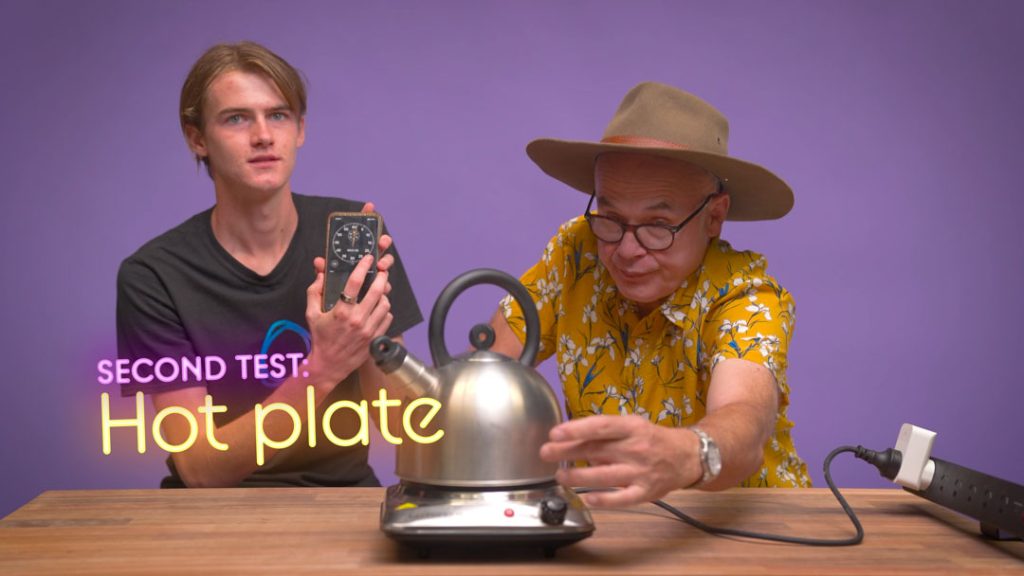
Jono: The futuristic induction stove came in at 2.10 cents in third place. And in second place we have the microwave, which costs 2 cents for electricity. And unfortunately for me, but luckily for you in the first place, we have the electric kettle at 1.16 cents. But Markus put these in figures so the viewers can understand.
Markus Lambert: So guys, if somebody has a cup every day for a year and uses this electric kettle versus somebody, let’s say, using the very inefficient hot plate per year, they will pay around $14 more just for the electricity each year.
Jono: Big deal.
Markus: Yeah. Hang on; some people have three cups a day. But if 10 million people in Australia all use an older style hot plate and now move to an efficient electric kettle, then we’re looking at a hundred and forty million dollars in savings in electricity per year. So we have a saying in Germany:
“Viele kleine Tiere machen auch viel Kot.”
Jono: Ah, of course, if I remember my German correctly, I’m pretty sure that translates to “a lot of small animals make a lot of poo too.”
Markus: Correct. So all those little cups of tea all together, more efficient, lots of poo. If it’s a billion people that used to do an inefficient way to heat hot water and move to an efficient way, then that means I can drive an electric car around the world with all those energy savings from a billion people. 800,000 times.
Jono: Wow. So what you’re saying is it all adds up by using electricity efficiently, be it air conditioning or heating, or a simple cup of tea. You can contribute to a global shift towards a greener world.
Markus: That’s correct. And you can enjoy your cup of tea. Guilt-free.
Want more energy answered? Visit YourEnergyAnswers.com for quality energy products, tools, and calculators, and find your quality local installers. Please support the channel by liking the video. Hit that subscribe button and ring the bell and check out all our other videos. You’re still here. I’ll see you next time. Bye.